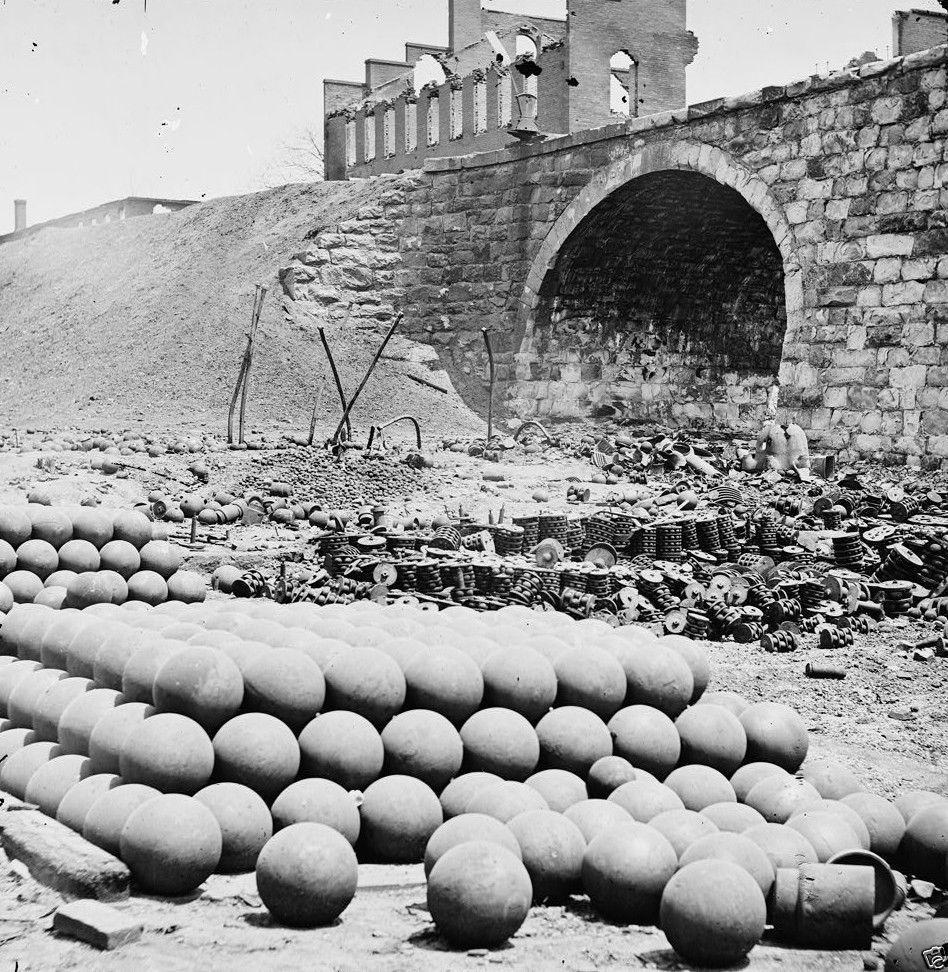
American Civil War Weaponry: Artillery Ordinance

Figure 1.--This photigraph was taken at the Confederate Richmond Arsenal after the Confederate Capital fell to the beseiging Federal forces (April 1865). You can see piles of artillery ordinance. We are not sure if the balls are solid or case shot. You can also see the canister shells. The Richmond & Petersburg Railroad bridge is on the right.
|
|
Cannonballs were solid, round objects that would ricochet off the ground and often used to target fortifications and enemy artillery. Highly effective anti-infantry ordinance was developed. The new 3-inch iron rifleled artillery pieces firing a 10-pound conical shot, had a flat trajectory with immense penetrating power. The old smoothbores had brass barrels with a 4.62-inch caliber, firing a 12-pound round shot, however, continuud to used throughout the War. This is because the primary purpose of artillery was to breakup and destroy enemy infantry charges. The Eastern United States is dominated by forested hills. And even the Western theater was mostly fought east of the Mississipi. In ths environment, a range of 1.5 km is all that the artillery needed to desimate an attacking infantry force. And for this purpose the smoothbore was often more effective than rifeled artillery. Case shot was an anti-personnel projectile. It looked like a cannon ball, but was hollow, filled with shrapnel. Once fired at an aattacking units, the shell would explode in mid-air, spreading the shrapnel across a large radius. As the enemy got closer, gunners would switch to canister or grapeshot. This was a tin can full of iron balls. A propellant at one end and a wooden disk at the other. The canon canister container disintegrated when the round was fired. This unleased deadly iron balls on the attacking eneny infantry line. Taking out whole sections of the attacking units. The smooth bore firing canister rounds was essentially a huge sawed-off shotgun. At a ranges of 250 meters or less it was murderous against massed infantry formations. We see that at Fredericksburg with attacking Federal firces (1862) and at Gettysburgh with attacking Confederate forces (1863).
CIH

Navigate the CIH World War II Pages :
[Return to Civil War artillery ]
[Return to Civil War weaponry]
[Return to Main Civil War page]
[Biographies]
[Campaign]
[Causes]
[Emancipation]
[Families and youth]
[Fiscal policy]
[Formations and units]
[Law]
[Railroads]
[Reconstruction]
[Slavery]
[Soldiers]
[Uniforms]
[Weaponry]
[Lost Cause]
[Civil Rights movement]
[Return to CIH Home page]
Created: 8:55 PM 10/25/2018
Last upodated: 8:55 PM 10/25/2018



